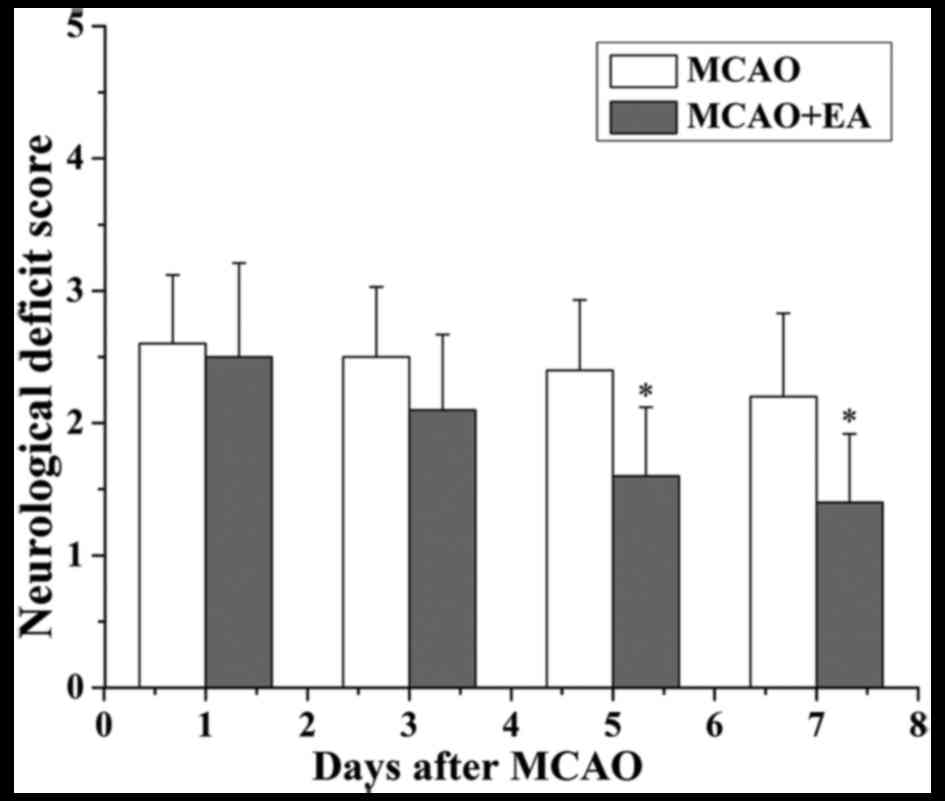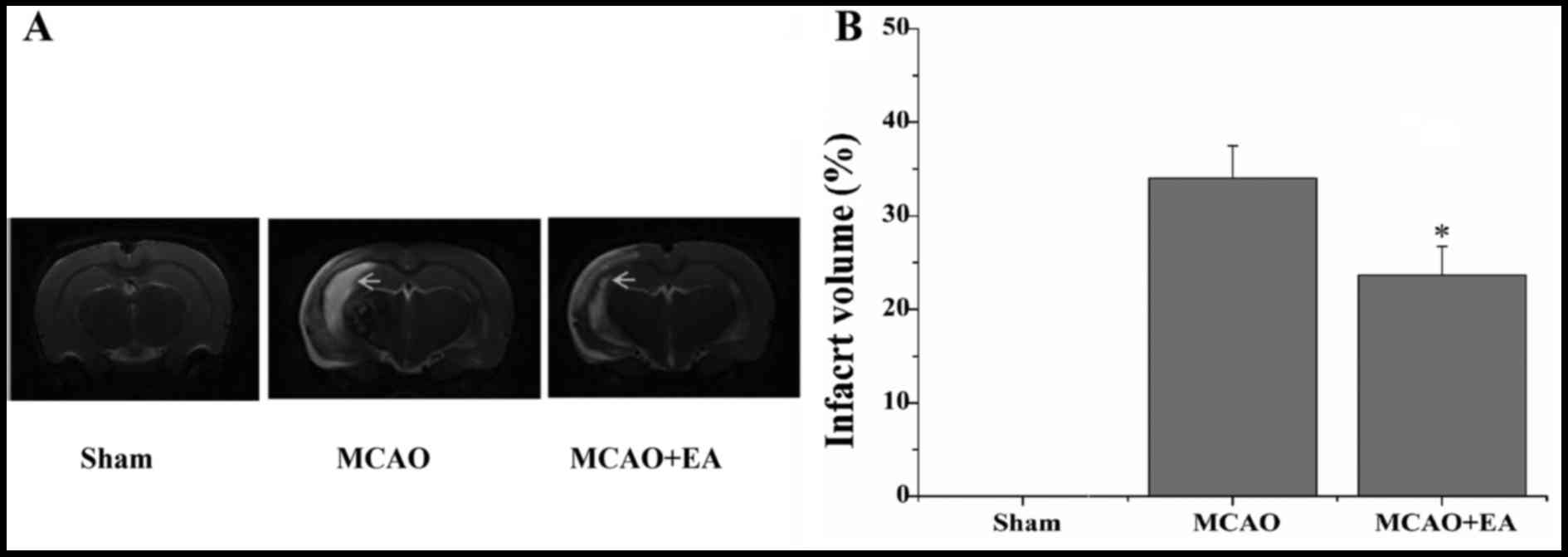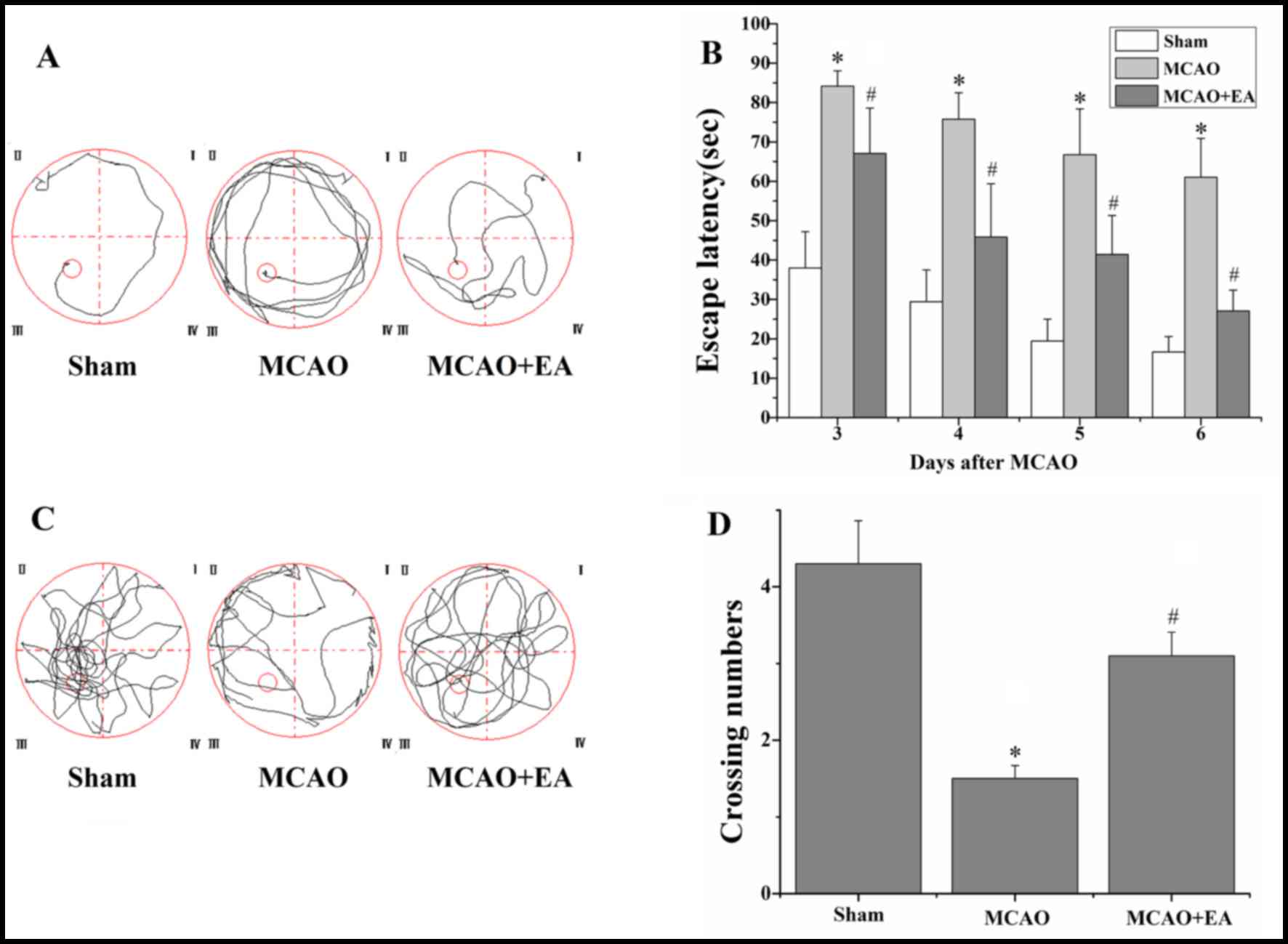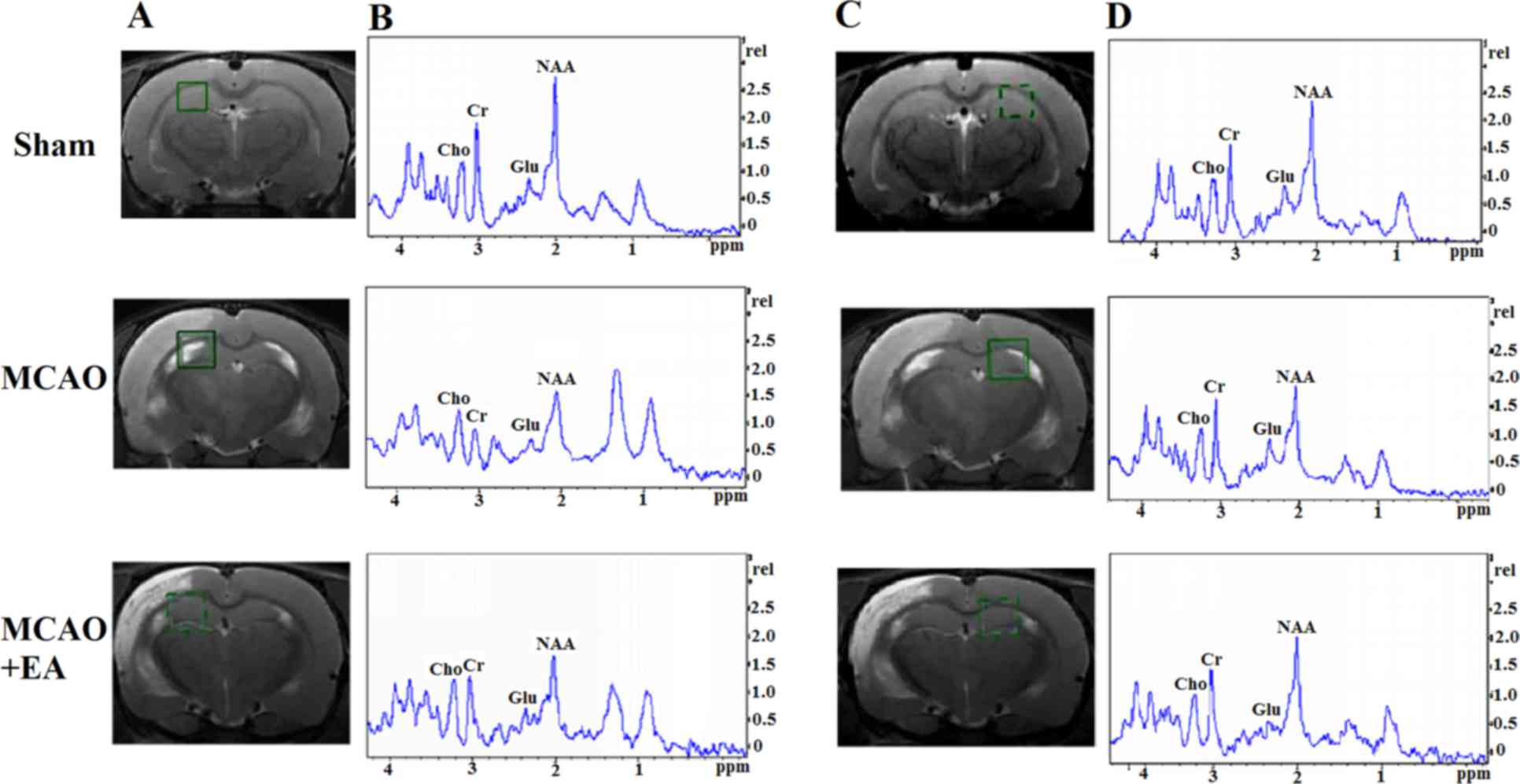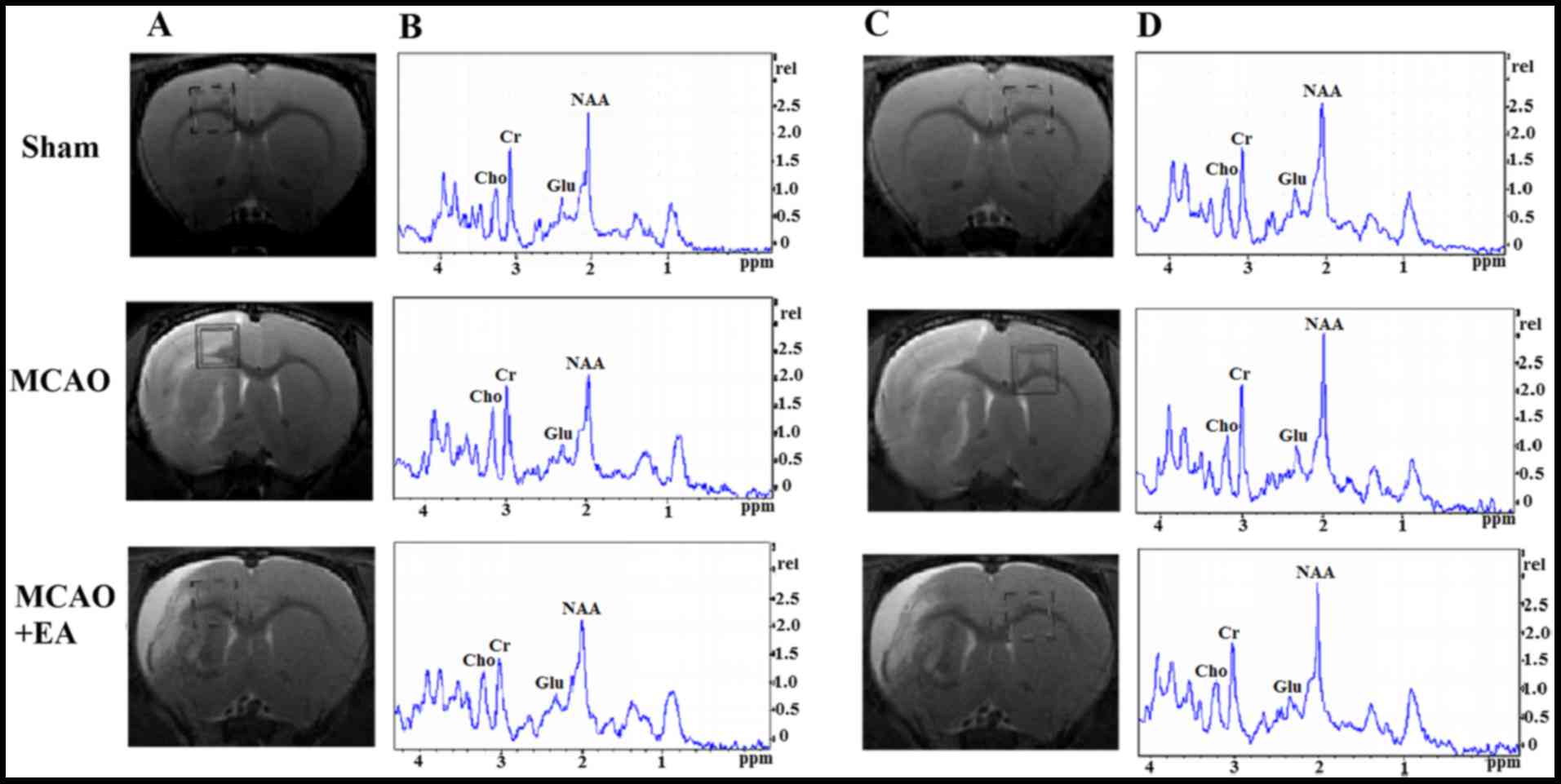|
1
|
Renjen PN, Gauba C and Chaudhari D:
Cognitive impairment after stroke. Cureus. 7:e3352015.PubMed/NCBI
|
|
2
|
Edwards JD, Jacova C, Sepehry AA, Pratt B
and Benavente OR: A quantitative systematic review of
domain-specific cognitive impairment in lacunar stroke. Neurology.
80:315–322. 2013. View Article : Google Scholar : PubMed/NCBI
|
|
3
|
Liu W, Wang X, Zheng Y, Shang G, Huang J,
Tao J and Chen L: Electroacupuncture inhibits inflammatory injury
by targeting the miR-9-mediated NF-κB signaling pathway following
ischemic stroke. Mol Med Rep. 13:1618–1626. 2016. View Article : Google Scholar : PubMed/NCBI
|
|
4
|
Li X, Guo F, Zhang Q, Huo T, Liu L, Wei H,
Xiong L and Wang Q: Electroacupuncture decreases cognitive
impairment and promotes neurogenesis in the APP/S1 transgenic mice.
BMC Complement Altern Med. 14:372014. View Article : Google Scholar
|
|
5
|
Ding X, Li CY, Wang QS, Du FZ, Ke ZW, Peng
F, Wang J and Chen L: Patterns in default-mode network connectivity
for determining outcomes in cognitive function in acute stroke
patients. Neuroscience. 277:637–646. 2014. View Article : Google Scholar : PubMed/NCBI
|
|
6
|
Witte AV, Kerti L, Margulies DS and Flöel
A: Effects of resveratrol on memory performance, hippocampal
functional connectivity, and glucose metabolism in healthy older
adults. J Neurosci. 34:7862–7870. 2014. View Article : Google Scholar : PubMed/NCBI
|
|
7
|
Rosenberg T, Gal-Ben-Ari S, Dieterich DC,
Kreutz MR, Ziv NE, Gundelfinger ED and Rosenblum K: The roles of
protein expression in synaptic plasticity and memory consolidation.
Front Mol Neurosci. 7:862014. View Article : Google Scholar : PubMed/NCBI
|
|
8
|
Yang M, Wang S, Hao F, Li Y, Tang H and
Shi X: NMR analysis of the rat neurochemical changes induced by
middle cerebral artery occlusion. Talanta. 88:136–144. 2012.
View Article : Google Scholar : PubMed/NCBI
|
|
9
|
Mattfeld AT and Stark CEL: Functional
contributions and interactions between the human hippocampus and
subregions of the striatum during arbitrary associative learning
and memory. Hippocampus. 25:900–911. 2015. View Article : Google Scholar : PubMed/NCBI
|
|
10
|
Shi L, Pu J, Xu L, Malaguit J, Zhang J and
Chen S: The efficacy and safety of cilostazol for the secondary
prevention of ischemic stroke in acute and chronic phases in Asian
population - an updated meta-analysis. BMC Neurol. 14:2512014.
View Article : Google Scholar
|
|
11
|
Liu ZY, Guo H, Zhang XL, Liu J, Qu HY,
Peng W, Bao YM, Yin LL and Song YX: Impacts of electroacupuncture
on left hippocampus NAA/Cr for patients of Uygur and Han
nationality with mild cognitive impairment. Zhongguo Zhen Jiu.
31:773–777. 2011.In Chinese. PubMed/NCBI
|
|
12
|
Feng X, Yang S, Liu J, Huang J, Peng J,
Lin J, Tao J and Chen L: Electroacupuncture ameliorates cognitive
impairment through inhibition of NF-κB-mediated neuronal cell
apoptosis in cerebral ischemia-reperfusion injured rats. Mol Med
Rep. 7:1516–1522. 2013. View Article : Google Scholar : PubMed/NCBI
|
|
13
|
Haga KK, Khor YP, Farrall A and Wardlaw
JM: A systematic review of brain metabolite changes, measured with
1H magnetic resonance spectroscopy, in healthy aging.
Neurobiol Aging. 30:353–363. 2009. View Article : Google Scholar
|
|
14
|
Longa EZ, Weinstein PR, Carlson S and
Cummins R: Reversible middle cerebral artery occlusion without
craniectomy in rats. Stroke. 20:84–91. 1989. View Article : Google Scholar : PubMed/NCBI
|
|
15
|
Tao J, Xue XH, Chen LD, Yang SL, Jiang SM,
Gao YL and Wang XB: Electroacupuncture improves neurological
deficits and enhances proliferation and differentiation of
endogenous nerve stem cells in rats with focal cerebral ischemia.
Neurol Res. 32:198–204. 2010. View Article : Google Scholar
|
|
16
|
Lan L, Tao J, Chen A, Xie G, Huang J, Lin
J, Peng J and Chen L: Electroacupuncture exerts anti-inflammatory
effects in cerebral ischemia-reperfusion injured rats via
suppression of the TLR4/NF-κB pathway. Int J Mol Med. 31:75–80.
2013. View Article : Google Scholar
|
|
17
|
Pouzet B, Zhang WN, Feldon J and Rawlins
JN: Hippocampal lesioned rats are able to learn a spatial position
using non-spatial strategies. Behav Brain Res. 133:279–291. 2002.
View Article : Google Scholar : PubMed/NCBI
|
|
18
|
Veng LM, Granholm AC and Rose GM:
Age-related sex differences in spatial learning and basal forebrain
cholinergic neurons in F344 rats. Physiol Behav. 80:27–36. 2003.
View Article : Google Scholar : PubMed/NCBI
|
|
19
|
Hui Xi G, Zhang J, Liu Z, Zhang S, Teng X,
Chan G, Wu KC, Nie EX, Shan BB, et al: Learning and memory
alterations are associated with hippocampal N-acetylaspartate in a
rat model of depression as measured by 1H-MRS. PLoS One.
6:e286862011. View Article : Google Scholar : PubMed/NCBI
|
|
20
|
Zhou IY, Chan RW, Ho LC and Wu EX:
Longitudinal metabolic changes in the hippocampus and thalamus of
the maternal brain revealed by proton magnetic resonance
spectroscopy. Neurosci Lett. 553:170–175. 2013. View Article : Google Scholar : PubMed/NCBI
|
|
21
|
Milner B and Klein D: Loss of recent
memory after bilateral hippocampal lesions: Memory and
memories-looking back and looking forward. J Neurol Neurosurg
Psychiatry. 87:2302016. View Article : Google Scholar
|
|
22
|
Jones RS and Waldman AD: 1H-MRS evaluation
of metabolism in Alzheimer's disease and vascular dementia. Neurol
Res. 26:488–495. 2004. View Article : Google Scholar : PubMed/NCBI
|
|
23
|
Bertolino A, Frye M, Callicott JH, Mattay
VS, Rakow R, Shelton-Repella J, Post R and Weinberger DR: Neuronal
pathology in the hippocampal area of patients with bipolar
disorder: A study with proton magnetic resonance spectroscopic
imaging. Biol Psychiatry. 53:906–913. 2003. View Article : Google Scholar : PubMed/NCBI
|
|
24
|
Jayaweera HK, Lagopoulos J, Duffy SL,
Lewis SJ, Hermens DF, Norrie L, Hickie IB and Naismith SL:
Spectroscopic markers of memory impairment, symptom severity and
age of onset in older people with lifetime depression: Discrete
roles of N-acetylaspartate and glutamate. J Affect Disord.
183:31–38. 2015. View Article : Google Scholar : PubMed/NCBI
|
|
25
|
Zhou IY, Ding AY, Li Q, McAlonan GM and Wu
EX: Magnetic resonance spectroscopy reveals N-acetylaspartate
reduction in hippocampus and cingulate cortex after fear
conditioning. Psychiatry Res. 204:178–183. 2012. View Article : Google Scholar : PubMed/NCBI
|
|
26
|
Penner J, Wells JL, Borrie MJ,
Woolmore-Goodwin SM and Bartha R: Reduced N-acetylaspartate to
creatine ratio in the posterior cingulate correlates with cognition
in Alzheimer's disease following four months of rivastigmine
treatment. Dement Geriatr Cogn Disord. 39:68–80. 2015. View Article : Google Scholar
|
|
27
|
Liu H and Wang X: Correlation of iron
deposition and change of gliocyte metabolism in the basal ganglia
region evaluated using magnetic resonance imaging techniques: An in
vivo study. Arch Med Sci. 12:163–171. 2016. View Article : Google Scholar : PubMed/NCBI
|
|
28
|
Stoiljkovic M, Leventhal L, Chen A, Chen
T, Driscoll R, Flood D, Hodgdon H, Hurst R, Nagy D, Piser T, et al:
Concentration-response relationship of the α7 nicotinic
acetyl-choline receptor agonist FRM-17874 across multiple in vitro
and in vivo assays. Biochem Pharmacol. 97:576–589. 2015. View Article : Google Scholar : PubMed/NCBI
|
|
29
|
Caldwell KK, Goggin SL, Tyler CR and Allan
AM: Prenatal alcohol exposure is associated with altered
subcellular distribution of glucocorticoid and mineralocorticoid
receptors in the adolescent mouse hippocampal formation. Alcohol
Clin Exp Res. 38:392–400. 2014. View Article : Google Scholar
|
|
30
|
Demougeot C, Marie C, Giroud M and Beley
A: N-acetylaspartate: A literature review of animal research on
brain ischaemia. J Neurochem. 90:776–783. 2004. View Article : Google Scholar : PubMed/NCBI
|
|
31
|
Aoki Y, Inokuchi R and Suwa H: Reduced
N-acetylaspartate in the hippocampus in patients with fibromyalgia:
A meta-analysis. Psychiatry Res. 213:242–248. 2013. View Article : Google Scholar : PubMed/NCBI
|
|
32
|
Lin R, Wu Y, Tao J, Chen B, Chen J, Zhao
C, Yu K, Li X and Chen LD: Electroacupuncture improves cognitive
function through Rho GTPases and enhances dendritic spine
plasticity in rats with cerebral ischemia-reperfusion. Mol Med Rep.
13:2655–2660. 2016. View Article : Google Scholar : PubMed/NCBI
|
|
33
|
Lin R, Lin Y, Tao J, Chen B, Yu K, Chen J,
Li X and Chen LD: Electroacupuncture ameliorates learning and
memory in rats with cerebral ischemia-reperfusion injury by
inhibiting oxidative stress and promoting p-CREB expression in the
hippocampus. Mol Med Rep. 12:6807–6814. 2015. View Article : Google Scholar : PubMed/NCBI
|
|
34
|
Zhang J and Shen Y: Magnetic resonance
spectroscopic study of memory impairment after cerebral infarction
treated with electroacupuncture. Zhongguo Zhen Jiu. 35:657–660.
2015.In Chinese. PubMed/NCBI
|
|
35
|
Zhao L, Zhang H, Zheng Z and Huang J:
Electroacupuncture on the head points for improving gnosia in
patients with vascular dementia. J Tradit Chin Med. 29:29–34. 2009.
View Article : Google Scholar : PubMed/NCBI
|



